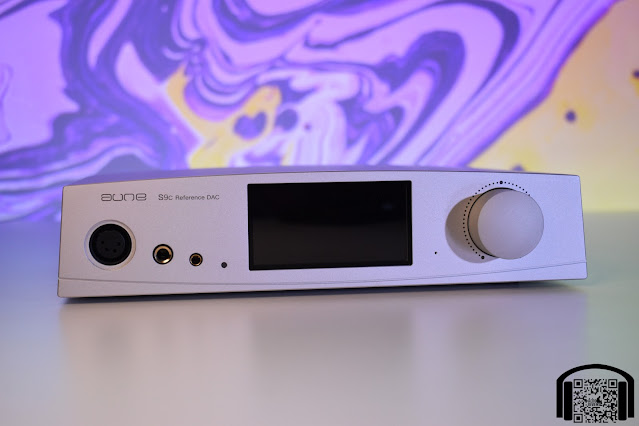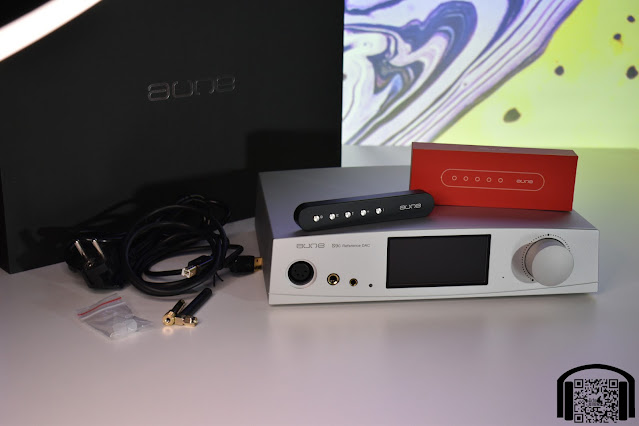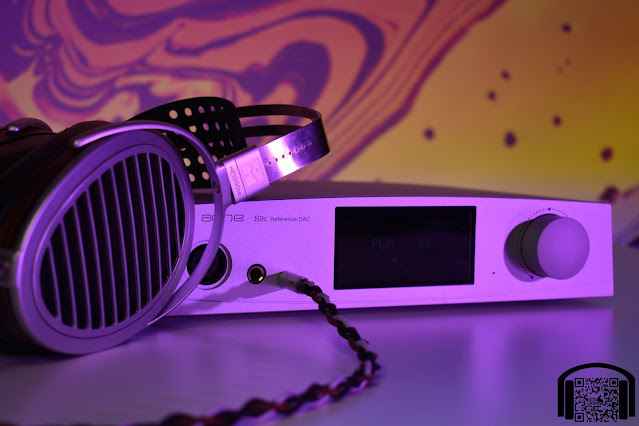I couldn’t find a thread for this device (sorry if I missed it) so I will leave my review here.
TLDR version on YouTube: TDLR - Aune S9c Pro
The S9c Pro has been loaned to me directly by Aune for me to try it out and to share my opinions in this review. Aune have not made any requests and I will do my best to be as unbiased as possible in my review, as always.
You can find the official page of the Aune S9c here: Aune S9c Pro Reference DAC Headphone Amp | Aune Store
As with all links I share, this is a non-affiliate link.
Intro…
I first heard about the S9c before heading to Munich back in May, while discussing a few new products with Aune. While in Munich, I did get to see the unit but I didn’t get to try it out at the time due to so many things going on. I did, however, arrange to have a unit sent to me on loan at a later date and while it has been a few months, I have finally had time to spend time with this DAC/Amp combo.
It may sound a bit crazy but I am currently on vacation and, along with some portable stuff and IEMs, the S9c made it into my luggage. It’s not exactly a device that one would think of packing to take on holiday, as it is rather large and heavy, but what better time to sit back and relax, spending time to get to know the device.
I needed something to put the S9c to the test and because I obviously could’t bring all my headphones, I brought a small selection that I have used to evaluate the device for this review. These are the Hifiman HE1000se, the Hifiman Arya v2 and the Sennheiser HD6XX. I would have brought the Arya Stealth as they are my usual go to but I forgot them in the office and I wasn’t going to swing by to pick them up, mainly to not risk getting caught up with work!
So, while this review may be a little different to my usual procedure, I think I have got to know the S9c pretty well and I will go through the normal steps of trying to explain my findings.
Presentation…
As I said, I had seen the S9c in Munich but I honestly didn’t remember it being as big as it is. When I received the box, inside another bigger box, I had no idea what was in it until I saw the Aune logo on the product box and then I thought, surely it’s not that big is it?
Well, it is rather large, yes. It is not the size of a rack mount pro amplifier but it is not far off. Packed inside a rather simple black box, the device comes well protected along with another smaller box that contains the remote control, the power cable, a USB A to USB B cable, a 3.5mm to 6.35mm adapter, the bluetooth antenna and a quick start guide.
There is nothing really special about the box or packaging, yet it does give the sensation of being a a higher end device, with simple but elegant packaging.
Build and aesthetics…
The S9c, as I said, is on the large side and is a very elegant looking device. The sides are slightly angled inwards and the top has a slight curve to it that makes it look sleeker and more modern in comparison to a simple rectangular box.
On the front of the device there is a large screen in the middle with white text that is also very elegant looking and shows all the necessary information without looking cluttered. In the top left corner of the screen it shows the selected input and the sound mode, while the top right shows the selected output. The center of the screen focuses on showing us the file type and bit rate, in slightly larger letters, although there are no decimal points so it shows “PCM 44” rather than 44.1 etc. Below this there is a curved bar, reminiscent of an eclipse, that shows a dot at the current volume level, with min and max at each end. I found the screen very difficult to photograph, so you will have to take my word for the fact that it looks a lot better in person than in images. Finally, under this curved bar, we get a symbol of a speaker (with bars that increase or decrease) along with a numeric reading of the volume (from 000 to 100).
I am very fond of the screen which, in its simplicity, looks very elegant. Things like the curved bar, with the curved min and max text at each end, go that extra step to turn useful into aesthetically pleasing.
To the left of the screen we have three outputs for headphones, these being a 4 pin XLR, a 6.35mm TRS and a 4.4mm TRRS. To the right of the display we have a large and very nice volume knob with dots sound it. While the knob looks and feels great, there is a little bit of a wiggle to it, which is a shame for an otherwise flawless front.
Moving around to the back, at the far left we have a set of balanced XLR outputs together with a set of unbalanced RCA outputs. Following these, from left to right, we have the inputs which are AES, coaxial digital, optical and USB. Just above these we have a 10M input for a clock and the connection point for the bluetooth antenna. Finally, at the far right, we have the IEC power connection and a mains power switch.
Last but not least we have the remote control. This is the same as the remote included with the Aune Flamingo I reviewed a while back and is completely made of black metal with silver buttons. I do find that the remote is very directional, in other worlds, you need to point it directly at the sensor for it to do anything, and the range isn’t great but that would be my only complaint in this category.
Honestly, looking at the build and all of the available inputs and outputs, I was very surprised to find out the price of the S9c. I may have been told it in the past and taken no notice but, when searching for info on the sound modes (which I’ll get to in a moment), I found that it retails here in Europe (from the official Aune store) for 749€. I honestly thought that it would be well into the 4 digit category.
Functionality…
While there is a lot going on with this device, the functionality and user interface has been kept very simple. You can do everything from the remote (which has 5 buttons) or from the single knob on the face of the unit.
Of course, first you connect whatever cables you need for your inputs and outputs, you flick on the power switch on the back and away you go.
Turning the knob obviously increases or lowers volume and I have to say that it is both precise and reliable. I fave found on many devices that turning a digital knob too quickly can cause it to skip (or even do other weird things on some devices) but that is not the case here. Turning it slowly allows you to go in single increments yet turning it fast still keeps it in single increments, just a lot faster. There is the feeling of a click with each increment and without even looking, this feedback will give you an idea of how far you have turned the knob, it is that precise. Due to it being digital, it also avoids any channel imbalance, no matter how low you go.
A single press of the knob will cycle through the inputs (USB/COX/OPT/AES/BT). I did find it amusing that they decided to label coaxial as COX rather than COAX or COA, but I guess that’s the inner child in me ![]() Each input change takes a second or so and you can here the double click of relays as one is disconnected and the other is engaged. It is also nice that USB connection is not broken when switching inputs, meaning music will continue to play and the PC won’t have a panic attack.
Each input change takes a second or so and you can here the double click of relays as one is disconnected and the other is engaged. It is also nice that USB connection is not broken when switching inputs, meaning music will continue to play and the PC won’t have a panic attack.
One thing to point out is that I did have to install the drivers from the Aune website for the PC to be able to play anything other than 48kHz through the S9c. If using the windows mixer, that is not an issue but for WASAPI or ASIO, drivers will need to be installed (at least on Windows 10).
A double press of the knob changes the selected output, cycling between headphone and line out. The line out is actually a pre-amp output, meaning that the volume control is functional when selected. The nice thing is that volume levels are remembered between the two outputs, so swapping from a line out at 100/100 back to headphones will not suddenly blast your headphones at full, it will remember the last setting you had.
Finally, a long press of the volume knob will change between the two sound modes. To my ears, the difference between the sound modes is that mode 2 gives the sensation of a larger soundstage. This makes there seem to be more space and openness in the recordings. I didn’t notice any other differences between the 2 modes, which is not to say they don’t exist, just that I didn’t notice them.
I didn’t test the clock input function as I don’t have a clock source to test it with (especially not here at the beach house) but it is covered in the user manual and seems to be pretty straightforward to use (basically you just plug it in and the S9c does the rest).
Sound…
I have been playing around with quite a few sources lately (with some more to come) and they have all placed towards the smooth side, where the Aune S9c is much more toward the analytical side of things. Saying that, it is not harsh.
Upon first listen with the HE1000se, I found things to be a little brighter than I am used to lately, yet, while the HE1000se can become a little too spicy in the treble if a source is too bright, I didn’t get that sensation with the S9c.
There is great balance and details to the presentation, with detail and space taking the forefront of the experience. This is not really a presentation that makes you switch off and just have music playing, it is more of a presentation that makes you take note of what is going on. As I said, it is not harsh, this is not a THX789, it is more of a “this is what the track sounds like and this is what your headphones can do with it” sort of thing.
Bass is quick, mids are neutral and treble is clean, all with plenty of detail going on. This is the sort of presentation that I love when I am focusing on music and wanting to experience all of it. I would say that this would work very well in a recording or production environment.
I listened to some of my test tracks (and quite a few others) that I know have minute details in the background that you need to focus on to know they are there. With the HE1000se, they were all very apparent and very impressive.
Moving on to the Arya v2, the soundstage of these headphones is already crazy and the S9c makes that even more apparent, especially when in sound mode 2. It is as though you are surrounded by a huge stage and can just pick things out millimetrically. I listened to a few live recordings (that I love to use the Arya v2 for) and you could quite easily notice any movement on stage while still being able to appreciate the things happening all around. I think if anyone wants to experience what a huge soundstage is, then a binaural recording of a live performance on the Arya v2 fed by the Aune S9c may be one of the most impressive demonstrations.
With the Sennheiser HD6XX there is a little bit less of that lushness that you get in the mids with something like a tube amp or a warmer/smoother amplifier, but at the same time, the detail that these headphones are capable of still surprises me. I wouldn’t say that the best experience with the HD6XX is focusing on detail, I prefer a warmer more intimate source as I think that is where these headphones excel, but it is still impressive to hear them powered by the S9c.
I also put on some IEMs, such as the Svanar, IE600 and a couple of others that I am testing at the moment. The S9c also did a great job with IEMs, maybe even better than with headphones.
The Svanar I find to be very revealing of source and, as with the IE600, I was very surprised as to how much detail these IEMs are capable of. I mean, they are a very good set of IEMs but I find that they focus on musicality more than minute detail, yet the S9c proved that they have all the detail that something like the HE1000se can provide. The IE600, with the custom tips, turned into a punchy and super clean set of IEMs that are fast and work wonders with quick and complex tracks.
As I said above, I have mainly been playing with smoother and warmer sources lately and the presentation of the S9c sort of reminded me how good some of these headphones and IEMs perform when focusing on dissecting the music!
Conclusion…
The Aune S9c is a very impressive DAC/Amp combo that I seriously thought would cost more than its 749€ price tag. It has all the inputs and outputs you could need (unless you want I2S) and even has an input for a clock, which may come in very handy for some, especially in a studio set up. I actually think this would be a great buy for somebody in a studio environment, be it production or recording, as it offers great detail and clarity without making things overly harsh.
Don’t let my description of the sound make you think that this device is going to be a bright and harsh presentation, it isn’t, it is still very musical, it is just more towards the analytical side of things than the warmer side of things.
When reviewing things, especially sources, it is very difficult to put into words the small changes between one device and another. To be honest, reviewers tend to make it sound like there is a huge difference between one source and another when there really isn’t. Yes, the differences are noticeable but they are not to the extreme, more of a flavour type of thing. And that is the case here, while some of the devices I have been using lately are more of a smooth flavour, the Aune is a more exciting flavour.
It has great looks (in my opinion), great build (except for that slight wiggle on the volume knob) and presents sound in a way that is very impressive, both with headphones and IEMs. All I can say is that I think the S9c is a lot of value for its asking price.
__
As always, this review is also available in Spanish both on my blog (www.achoreviews.com) and on YouTube (www.youtube.com/achoreviews)






